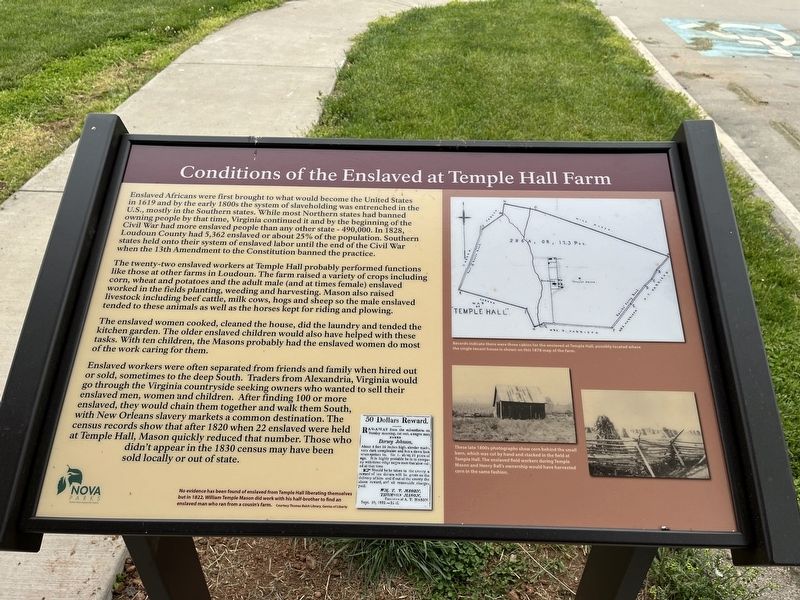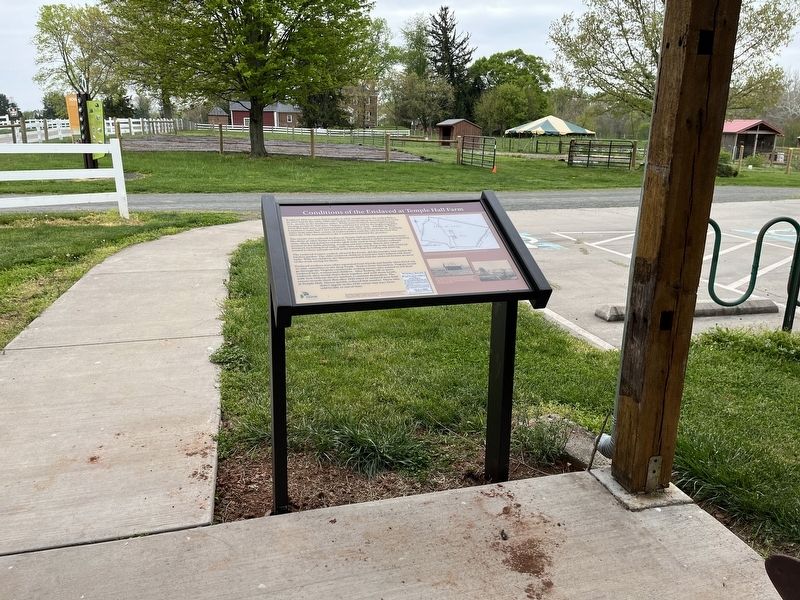Leesburg in Loudoun County, Virginia — The American South (Mid-Atlantic)
Conditions of the Enslaved at Temple Hall Farm

Photographed By Devry Becker Jones (CC0), May 1, 2022
1. Conditions of the Enslaved at Temple Hall Farm Marker
Enslaved Africans were first brought to what would become the United States in 1619 and by the early 1800s the system of slaveholding was entrenched in the U.S., mostly in the Southern states. While most Northern states had banned owning people by that time, Virginia continued it and by the beginning of the Civil War had more enslaved people than any other state — 490,000 In 1828, Loudoun County had 5,362 enslaved or about 25% of the population. Southern states held onto their system of enslaved labor until the end of the Civil War when the 13th Amendment to the Constitution banned the practice.
The twenty-two enslaved workers at Temple Hall probably performed functions like those at other farms in Loudoun. The farm raised a variety of crops including corn, wheat and potatoes and the adult male (and at times female) enslaved worked in the fields planting, weeding and harvesting. Mason also raised livestock including beef cattle, milk cows, hogs and sheep so the male enslaved tended to these animals as well as the horses kept for riding and plowing.
The enslaved women cooked, cleaned the house, did the laundry and tended the kitchen garden. The older enslaved children would also have helped with these tasks. With ten children, the Masons probably had the enslaved women do most of the work caring for them.
Enslaved workers were often separated from friends and family when hired out or sold, sometimes to the deep South. Traders from Alexandria, Virginia would go through the Virginia countryside seeking owners who wanted to sell their enslaved men, women and children. After finding 100 or more enslaved, they would chain them together and walk them together and walk them South, with New Orleans slavery markets a common destination. The census records show that after 1820 when 22 enslaved were held at Temple Hall, Mason quickly reduced that numbers. Those who didn't appear in the 1830 census may have been sold locally or out of state.
[Captions:]
No evidence has been found of enslaved from Temple Hall liberating themselves but in 1822, William Temple Mason did work with his half-brother to find an enslaved man who ran from a cousin's farm.
Records indicate there were three cabins for the enslaved at Temple Hall, possibly located where the single tenant house is shown on this 1878 map of the farm.
These late 1800s photographs show corn behind the small barn, which was cut by hand and stacked in the field at Temple Hall. The enslaved field workers during Temple Mason and Henry Ball's ownership would have harvested corn in the same fashion.
Erected by NOVA Parks.
Topics and series. This historical

Photographed By Devry Becker Jones (CC0), May 1, 2022
2. Conditions of the Enslaved at Temple Hall Farm Marker
Location. 39° 10.751′ N, 77° 31.696′ W. Marker is in Leesburg, Virginia, in Loudoun County. Marker is on Temple Hall Lane, 0.3 miles north of Limestone School Road (Virginia Route 661). Touch for map. Marker is at or near this postal address: 15783 Temple Hall Ln, Leesburg VA 20176, United States of America. Touch for directions.
Other nearby markers. At least 8 other markers are within 2 miles of this marker, measured as the crow flies. Welcome to Temple Hall Farm Regional Park (here, next to this marker); Enslaved Workers at Temple Hall Farm (here, next to this marker); The Kincaid Farm Barns (a few steps from this marker); This Is Temple Hall! (a few steps from this marker); 1862 Antietam Campaign (approx. 1.7 miles away in Maryland); White’s Ferry (approx. 1.7 miles away in Maryland); Gettysburg Campaign (approx. 1.7 miles away in Maryland); The History of White's Ferry (approx. 1.8 miles away in Maryland). Touch for a list and map of all markers in Leesburg.
Additional keywords. human trafficking; enslaved labor
Credits. This page was last revised on May 1, 2022. It was originally submitted on May 1, 2022, by Devry Becker Jones of Washington, District of Columbia. This page has been viewed 125 times since then and 16 times this year. Photos: 1, 2. submitted on May 1, 2022, by Devry Becker Jones of Washington, District of Columbia.